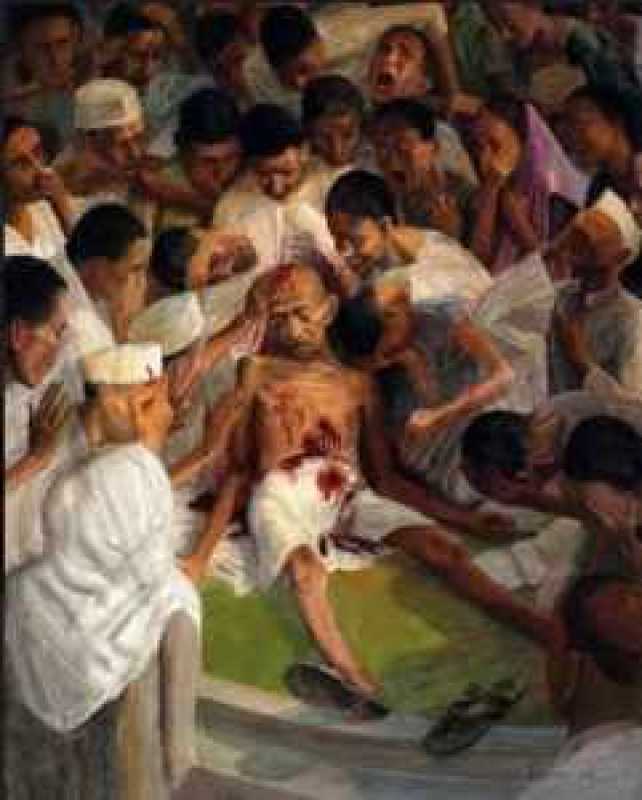Entertainment
Artifacts of Gandhi’s Assassination: Visual and Material Culture Depicting the Dying Moment of the Mahatma

At the twilight of January 30, 1948, the echoes of three gunshots pierced the stillness at Birla House in New Delhi, abruptly silencing one of the greatest voices of the Indian national movement. As Mahatma Gandhi took his last breath, uttering the words ‘Hey Ram,’ his passing breathed new life into the recently liberated nation. Over the past seven decades, countless efforts have been made to narrate, debate, and reflect upon the momentous event that shaped Indian history forever. However, due to the absence of a camera to capture the precise moment, the dying instant of Gandhi’s life remains an imagined and elusive fragment of history.
In a recent lecture hosted by the University of Chicago Center in New Delhi, historian Sumathi Ramaswamy unveiled her ongoing project titled “The optics of a dying moment in the life of a nation.” This ambitious endeavor delves deep into the visual and material culture that has preserved and immortalized the dying moment of Mahatma Gandhi. Ramaswamy seeks to explore the role of art in perpetuating the memory of this significant event, examining how artists have depicted and contoured the narrative surrounding Gandhi’s death.
Ramaswamy’s project encompasses a wide range of artistic expressions, including paintings, lithographs, sculptures, and digital art. From mass-produced posters and pamphlets to high art created by renowned artists, the collection represents various interpretations of Gandhi’s final moments. Spanning from traditional images in the Gandhian photographic archives to more contemporary and avant-garde representations, each artwork delves into the theme of ‘lastness’ – Gandhi’s final days, possessions, walks, and, perhaps most significantly, his last utterance.
While there is no standardized visualization of Gandhi’s death in art, Ramaswamy notes the existence of chromo-lithographs that portrayed Gandhi standing tall and smiling, blood oozing from his three wounds onto the nation’s map. Other depictions show Gandhi in the arms of Mother India, tears streaming down her face. Some artworks draw parallels between Gandhi’s death, and those of Christ and Buddha, evoking a sense of martyrdom and sacrifice. It is intriguing to note how these interpretations repurpose well-known photographs of Gandhi to dwell on his dying moment.
High art created by academic painters also contributes to the visual representation of Gandhi’s assassination. For instance, Upendra Maharathi, an Oriental modernist painter from Orissa, incorporated figures of Buddha and Christ into his contemplation of the murder scene. Cruzo, a Goan artist based in Bombay, introduced Christian motifs in his work, featuring a depiction of Gandhi lying flanked by Abha and Manu, his spectacles and sandals abandoned as blood drips from his bullet wounds to the ground.
Additional artists, such as Atul Dodiya and Krishen Khanna, center their works on the assassination despite Gandhi’s absence in the imagery. The spectacles, sandals, stick, his final walk, and the words he spoke in his dying moments continue to captivate the artist’s imagination. Interestingly, even Muslim artists like Syed Haider Razak represented Gandhi’s last utterance, ‘He Ram,’ using the Nagari script, affirming his Hindu identity and fidelity to the Indian nation despite rising communal tensions following the partition.
Notably, several artists have included Nathuram Godse, Gandhi’s assassin, in their visualizations of the dying moment. Although no photograph of the two together exists, the concept of ‘lastness’ brings them together in these artworks. Among this vast collection, Debanjan Roy’s portrayal stands out as enigmatic and provocative. Roy merges the faces of Gandhi and Godse, with blood-red streaks across the paper, prompting viewers to reflect on the paradoxical intimacy Godse sought to establish with Gandhi through his act.
Gandhi’s death complicates our understanding of the birth of the Indian nation in various ways. It challenges the notion of a completely non-violent national movement and forces us to confront the violent origins of Indian nationalism, particularly in conjunction with the partition. Through her project, Ramaswamy prompts us to consider how visual and material culture shape our perception of Gandhi’s death and the nation it gave birth to. She emphasizes that once artists release their work into the world, they lose control over its interpretation and application.
Sumathi Ramaswamy’s research sheds light on the profound impact art has had on preserving and perpetuating the dying moment of Mahatma Gandhi. By examining the diverse and intricate artworks that depict this pivotal event, her project offers a unique perspective on the visual and material culture surrounding Gandhi’s assassination and its lasting significance in Indian history.












